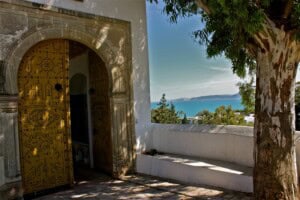In post-revolution Tunisia, Naomi Tolley discovers a peaceful land with a positive air, and a unique tourism business that one man has built with his own hands
Here at a dusty Tunisian crossroads overlooking the Mediterranean Sea, we’re waiting for a man named Goulli. It’s midmorning near Bizerte and the relentless Arabian sun is already drenching the ochre soil beneath our feet with a searing heat. But the air is thick with optimism.
“This is something special, a big surprise,” says our guide, Walid Ben Ammar, reluctant to divulge the details of where we’re going for fear of tainting our wonder. Then, in a cloud of dust and a white 4×4 which bumps to a halt, Goulli arrives, emerging from his vehicle grinning from ear to ear.
“Welcome,” he says, with a fervent pride and an eagerness to shake our hands. “Welcome to this, the only place like it in Tunisia. I am Raouf, Goulli Raouf.” Then he ushers me to sit beside him in the passenger seat before speeding off, leaving the men among us to walk.
“There are many people who have not come here yet,” he says, “so, so long in taking time to make happen.”
We arrive at a clearing on a humble hillock overlooking an expanse of deep blue sea and a cove with sand as cream and squishy as warm rice pudding. A series of handmade wooden stairways, railings, gates and platforms subtly cling to the cliff face and straw umbrellas perch above handmade wooden picnic tables, as though tourists were expected for lunch at any minute.
This is as remote, as unspoilt, and as unique as any place can get. And what’s more, after a severe “suppression” from the pre-revolution regime, it has taken Goulli more than a decade to make this much headway – with nothing but his bare hands and a vision, he says.
“For 10 years I have been working underground for this but only now, after the revolution am I free to make it happen.”
“This is as remote, as unspoilt, and as unique as any place can get”
It is since the Jasmine Revolution – an uprising that sparked the Arab Spring and resulted in ex-president Ben Ali stepping down last year after 23 years of authoritarian rule in favour of a transitional government – that the Tunisian people have felt a freedom to bring their dreams to fruition, they say.
Goulli leads us down a rickety wooden staircase, over a sandy inlet and into a former Berber pirate cave; a hidden hollow beneath the cliff top, which will now function as a waterside restaurant. With its white-sand floor, lanterns and “the music of the sea,” as Goulli puts it, I find it delightful.
It is from this setting that he plans to run his eco-tourism business, hosting guests for team building, scuba diving, horse-riding and other activity breaks – with dinner and breakfast available in the ‘cave’. I have never seen anything quite like it in the 15 years I have been travelling: it is unique, an expression of love, determination and courage; built from raw materials with one man’s bare hands.
Conservation has been key here, with nature at the forefront of Goulli’s mind. There isn’t a man-made material in sight. Stairways, gates, seats and furnishings all made from wood, flow together with the natural curves of the land which couple to form a beautiful and sensitively designed holiday retreat. There is nothing but the call of the wild, the roar of the sea, and Goulli’s chatterings for company – and he wants to keep it that way. “This is nature’s paradise – for people to share and enjoy,” he says.
Goulli plans to officially open the project to the public in 2012 and I leave, vowing to return. His story serves as a prime example of a suppressed Tunisian people who have been and are eager to work, eager to shine and to draw tourists to this beautiful country on Africa’s northernmost tip. You can sense their determination everywhere, it’s almost tangible.
Back in the capital, Tunis, you could cut the air of this freshly-found buoyancy with a knife on the tree-lined Habib Bourguiba Avenue. Rows of the nation’s red and white flags flutter above a cosmopolitan, convivial affair while bright yellow taxis bring more people to this already bustling central thoroughfare.
It’s a different scene from that of two years ago: “It [the revolution] started right here,” says Walid, as we walk along a section of the avenue, named after the first president of the Republic of Tunisia.
“Now, after that time, it is totally different,” he continues, as a plane flies overhead, bringing more tourists to the capital. “People wanted to express their opinions against tyranny, they wanted to revolt against things like unemployment. Now their opinions aren’t suppressed, people are more positive – they have a say.”
Tourism returns to Tunisia
– The renowned Bardo National Museum in the capital city of Tunis reopened its doors to visitors in May after years of expansion and renovation. The exhibition showcases ancient mosaics, the oldest dating back to the 2nd century.
– Star Wars fanatics flocked to Tunisia this year as the cult film celebrated its 35th anniversary. The Tunisian Sahara provided much of the movie’s background.
– UK visitors to Tunisia more than doubled in July 2012, with a 50.7% increase on July 2011. The country saw a 7.2% increase on the country’s record-breaking visitor figures of July 2010.
– To date, over 180,000 visitors from the UK and Ireland have traveled to Tunisia this year. Irish visitors increased 83.9% in the first half of 2012 compared to last year.

